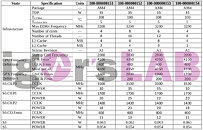- Joined
- Oct 9, 2007
- Messages
- 47,297 (7.53/day)
- Location
- Hyderabad, India
| System Name | RBMK-1000 |
|---|---|
| Processor | AMD Ryzen 7 5700G |
| Motherboard | ASUS ROG Strix B450-E Gaming |
| Cooling | DeepCool Gammax L240 V2 |
| Memory | 2x 8GB G.Skill Sniper X |
| Video Card(s) | Palit GeForce RTX 2080 SUPER GameRock |
| Storage | Western Digital Black NVMe 512GB |
| Display(s) | BenQ 1440p 60 Hz 27-inch |
| Case | Corsair Carbide 100R |
| Audio Device(s) | ASUS SupremeFX S1220A |
| Power Supply | Cooler Master MWE Gold 650W |
| Mouse | ASUS ROG Strix Impact |
| Keyboard | Gamdias Hermes E2 |
| Software | Windows 11 Pro |
Igor's Lab discovered that AMD may be working on as many as twelve desktop Ryzen G "Renoir" processors with integrated graphics. These include six SKUs each covering the 65 W and 35 W TDP categories, and include two each of 8-core/16-thread, 6-core/12-thread, and 4-core/8-thread SKUs per TDP category. All twelve chips feature increased power limits from their mobile siblings, and a reference memory frequency of DDR4-3200. The parts also feature iGPU maximum engine clock boost frequency as high as 2.10 GHz, to overcome the compute unit deficit "Renoir" has against its predecessor, "Picasso/Raven Ridge," with their up to 11 CUs.
The series appears to be led by an 8-core/16-thread SKU with CPU boost frequency as high as 4.45 GHz, iGPU engine clock as high as 2.10 GHz, and various power-state clock speeds detailed in the table below. The 6-core/12-thread part boosts up to 4.30 GHz, with iGPU engine clock up to 1.90 GHz. The 4-core/8-thread part boosts up to 4.10 GHz, with up to 1.70 GHz iGPU engine clocks. The 35 W TDP parts have, on average, 200-300 MHz lower max CPU core boost- and nominal clock speeds, but more aggressive power-management as defined in the various P-states. Half of these OPNs point to chips with identical clock speeds and core configurations. These are probably differentiated from each other with some of them being Ryzen PRO SKUs.



It stands to reason that all SKUs will be launched under the upcoming Ryzen 4000G-series branding. We already know that the 8-core parts will get a Ryzen 7 brand extension from the Ryzen 7 4700G leak. It's possible that the Ryzen 5 parts will be 6-core/12-thread, and Ryzen 3 4-core/8-thread. For the Ryzen 5 desktop APU series in particular, this would amount to a 50% increase in core- and thread-counts (from the 3400G), while it would see the introduction of SMT for Ryzen 3 desktop APU series (from the 3200G). Find some technical commentary in the Igor's Lab report at the source link below.
View at TechPowerUp Main Site
The series appears to be led by an 8-core/16-thread SKU with CPU boost frequency as high as 4.45 GHz, iGPU engine clock as high as 2.10 GHz, and various power-state clock speeds detailed in the table below. The 6-core/12-thread part boosts up to 4.30 GHz, with iGPU engine clock up to 1.90 GHz. The 4-core/8-thread part boosts up to 4.10 GHz, with up to 1.70 GHz iGPU engine clocks. The 35 W TDP parts have, on average, 200-300 MHz lower max CPU core boost- and nominal clock speeds, but more aggressive power-management as defined in the various P-states. Half of these OPNs point to chips with identical clock speeds and core configurations. These are probably differentiated from each other with some of them being Ryzen PRO SKUs.



It stands to reason that all SKUs will be launched under the upcoming Ryzen 4000G-series branding. We already know that the 8-core parts will get a Ryzen 7 brand extension from the Ryzen 7 4700G leak. It's possible that the Ryzen 5 parts will be 6-core/12-thread, and Ryzen 3 4-core/8-thread. For the Ryzen 5 desktop APU series in particular, this would amount to a 50% increase in core- and thread-counts (from the 3400G), while it would see the introduction of SMT for Ryzen 3 desktop APU series (from the 3200G). Find some technical commentary in the Igor's Lab report at the source link below.
View at TechPowerUp Main Site





 That's like comparing two CPU's just by looking at the number of cores alone..
That's like comparing two CPU's just by looking at the number of cores alone..